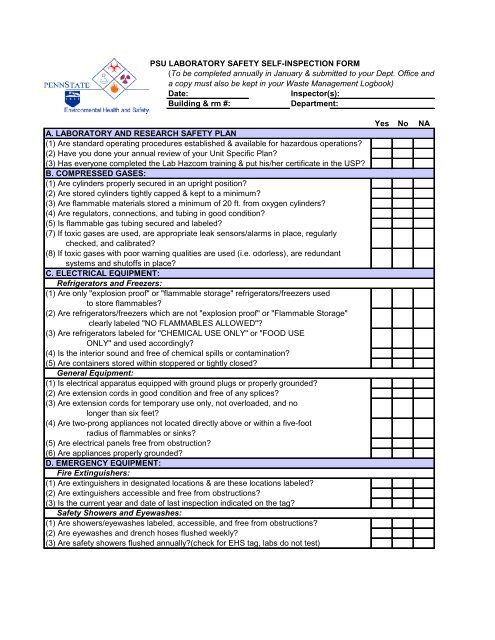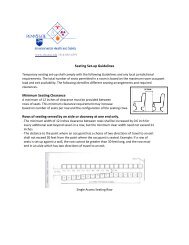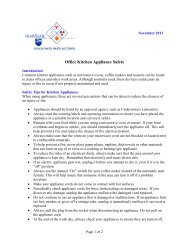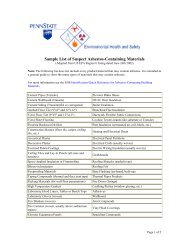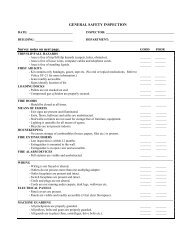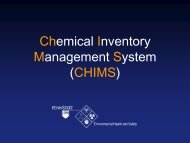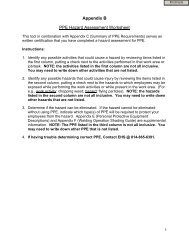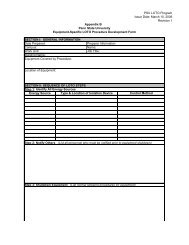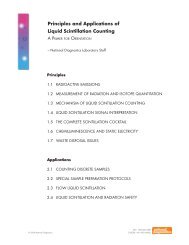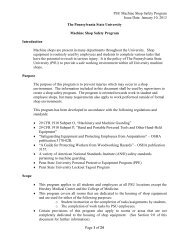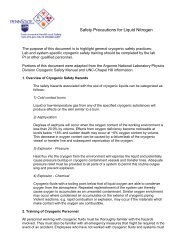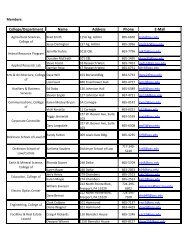Laboratory Self Inspection Form
Laboratory Self Inspection Form
Laboratory Self Inspection Form
Create successful ePaper yourself
Turn your PDF publications into a flip-book with our unique Google optimized e-Paper software.
PSU LABORATORY SAFETY SELF-INSPECTION FORM<br />
(To be completed annually in January & submitted to your Dept. Office and<br />
a copy must also be kept in your Waste Management Logbook)<br />
Date:<br />
Inspector(s):<br />
Building & rm #:<br />
Department:<br />
A. LABORATORY AND RESEARCH SAFETY PLAN<br />
(1) Are standard operating procedures established & available for hazardous operations?<br />
(2) Have you done your annual review of your Unit Specific Plan?<br />
(3) Has everyone completed the Lab Hazcom training & put his/her certificate in the USP?<br />
B. COMPRESSED GASES:<br />
(1) Are cylinders properly secured in an upright position?<br />
(2) Are stored cylinders tightly capped & kept to a minimum?<br />
(3) Are flammable materials stored a minimum of 20 ft. from oxygen cylinders?<br />
(4) Are regulators, connections, and tubing in good condition?<br />
(5) Is flammable gas tubing secured and labeled?<br />
(7) If toxic gases are used, are appropriate leak sensors/alarms in place, regularly<br />
checked, and calibrated?<br />
(8) If toxic gases with poor warning qualities are used (i.e. odorless), are redundant<br />
systems and shutoffs in place?<br />
C. ELECTRICAL EQUIPMENT:<br />
Refrigerators and Freezers:<br />
(1) Are only "explosion proof" or "flammable storage" refrigerators/freezers used<br />
to store flammables?<br />
(2) Are refrigerators/freezers which are not "explosion proof" or "Flammable Storage"<br />
clearly labeled "NO FLAMMABLES ALLOWED"?<br />
(3) Are refrigerators labeled for "CHEMICAL USE ONLY" or "FOOD USE<br />
ONLY" and used accordingly?<br />
(4) Is the interior sound and free of chemical spills or contamination?<br />
(5) Are containers stored within stoppered or tightly closed?<br />
General Equipment:<br />
(1) Is electrical apparatus equipped with ground plugs or properly grounded?<br />
(2) Are extension cords in good condition and free of any splices?<br />
(3) Are extension cords for temporary use only, not overloaded, and no<br />
longer than six feet?<br />
(4) Are two-prong appliances not located directly above or within a five-foot<br />
radius of flammables or sinks?<br />
(5) Are electrical panels free from obstruction?<br />
(6) Are appliances properly grounded?<br />
D. EMERGENCY EQUIPMENT:<br />
Fire Extinguishers:<br />
(1) Are extinguishers in designated locations & are these locations labeled?<br />
(2) Are extinguishers accessible and free from obstructions?<br />
(3) Is the current year and date of last inspection indicated on the tag?<br />
Safety Showers and Eyewashes:<br />
(1) Are showers/eyewashes labeled, accessible, and free from obstructions?<br />
(2) Are eyewashes and drench hoses flushed weekly?<br />
(3) Are safety showers flushed annually?(check for EHS tag, labs do not test)<br />
Yes No NA
First Aid:<br />
(1) Are first aid kits stored in designated areas?<br />
(2) Is the kit properly stocked according to University Policy SY-21?<br />
E. HAZARDOUS SUBSTANCES:<br />
Chemical Storage:<br />
(1) Has chemical inventory been updated annually in CHIMS?<br />
(2) Are chemicals dated upon receipt?<br />
(3) Are chemical containers labeled, capped, and in good condition?<br />
(4) Is the storage of chemicals on, above, or next to a desk avoided?<br />
(5) Are all corrosive chemicals stored below "eye level"?<br />
(6) Are chemicals segregated by hazard (organics away from oxidizers,<br />
flammables away from acids)?<br />
(7) Is chemical storage kept to a minimum?<br />
Solvent Storage:<br />
(1) Is excess solvent stored in approved safety cans or solvent storage<br />
cabinets and not placed high on shelving?<br />
(2) Are approved safety cans equipped with self-closing lids and are flame<br />
arrestors intact?<br />
(3) Are safety can lids closed?<br />
(4) Are safety cans/wash bottles properly labeled?<br />
Infectious/Chemical Waste:<br />
(1)Designated Chemical Accumulation area with room and bldg. listed in log book?<br />
(2) Are waste containers labeled and chemical compositions identified?<br />
(3) Are waste areas inspected weekly and documentation maintained?<br />
(4) Is waste stored in secondary containment?<br />
(5) Have waste area overseer and Supervisor been designated?<br />
(6) Is total volume of all chemical waste < 55 gallons?<br />
(7) Are biohazard containers properly used where needed (i.e. autoclave<br />
bags, sharps containers)?<br />
<strong>Laboratory</strong> Hoods/Local Exhaust:<br />
(1) Are exhaust hoods working properly? (Confirm date of last inspection).<br />
(2) Do hood sashes open/close properly and is glass intact?<br />
(3) Is hood free of excess chemical storage/equipment?<br />
(4) Are hood sashes down (panels closed) when not accessing?<br />
F. PROTECTIVE EQUIPMENT:<br />
Personal Equipment:<br />
(1) Are safety glasses with side shields worn as required?<br />
(2) Are substantial shoes worn with no sandals or open toes?<br />
(3) Is protective clothing worn while working at benches?<br />
(4) Are gloves selected and worn according to hazard?<br />
(5) Are chemical splash goggles/face shields worn when appropriate?<br />
Other Equipment:<br />
(1) Is proper protective equipment in place (shields,guards, warning signs,etc?<br />
(2) Is secondary containment used for Hg use and storage?<br />
General Housekeeping:<br />
(1) Are aisles and exits free from obstructions?<br />
(2) Are benches/shelves not overloaded with unused equipment/chemicals?<br />
(3) Are no combustibles stored within three feet of the ceiling?<br />
(4) Is no damaged glassware in use (i.e. broken or chipped)?<br />
(5) Is lab apparatus properly assembled and used in a safe manner?<br />
(6) Are bicycles not stored in lab?<br />
Yes No NA
G. SIGNS:<br />
(1) Are special hazard signs in place (i.e. lasers, cryogenic hazards, biohazards)?<br />
(2) Are lab doors labeled and information up-to-date?<br />
H. TRAINING:<br />
(1) Have lab personnel been instructed in potential hazards and lab safety practices?<br />
(3) Have all personnel in lab (including PI) received initial <strong>Laboratory</strong> Safety training?<br />
(4) Have all personnel in lab (including PI) completed the lab safety mandatory refresher<br />
training?<br />
(5) Has a copy of the training records been sent to your Dept. office?<br />
I. VACUUM EQUIPMENT:<br />
(1) Are vacuum pump belt guards in place?<br />
(2) Are glass Dewars wrapped or shielded?<br />
(3) Are protective shatterproof shields in place when vacuum equip. is used?<br />
(4) Are glass desiccators under vacuum stored in metal guards or shielded?<br />
J. SECURITY (PSU POLICY SY-24):<br />
(1) Are radioactive, biohazardous material, and hazardous materials secured from<br />
unauthorized removal?<br />
(2) Is lab familiar with PSU Policy SY-24 Use of Biohazardous Materials in Research<br />
and Instruction and conducting annual inventory of materials regulated<br />
by this policy?<br />
Yes No NA<br />
_______________________________________________________________________<br />
Name of Principal Investigator (print)<br />
Signature of Principal Investigator<br />
_______________________________________________________________________<br />
Name of Department Head (print)<br />
Signature of Department Head
t. Office and


